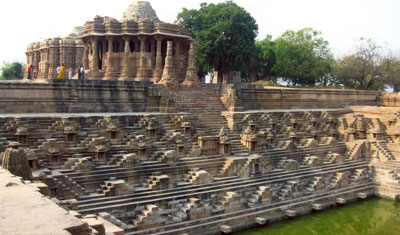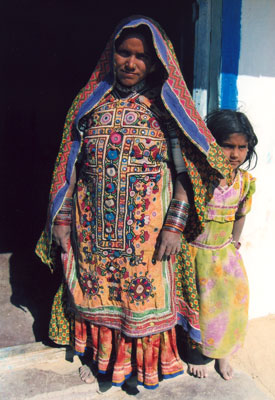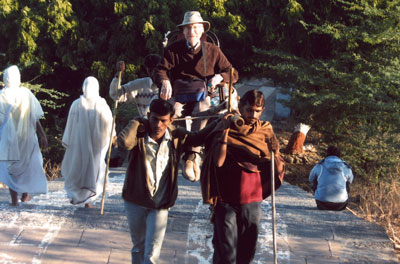Discovering incredible diversity in Gujarat, India
by Julie Skurdenis, Contributing Editor. Photos by Paul Lalli
I consider myself a seasoned Indophile. With four previous trips to India spread out over a dozen years, I thought I had seen the best this vast subcontinent had to offer. On my fifth trip, in January ’08, I wanted to revisit a few old favorites, like the Taj Mahal, plus add something totally new.
My husband, Paul, and I chose Gujarat, a state in the northwest of India that juts out into the Arabian Sea. It turned out to be the right choice. Relatively untouristed Gujarat offers incredible diversity.
A land of contrasts
First is the landscape. Bone-dry deserts in the north of Gujarat are balanced by palm-fringed beaches in the south. Arid salt pans alternate with verdant cotton fields. Dotted throughout are teakwood forests and mango groves.
To this landscape add exuberantly carved Hindu temples and austere Islamic mosques; ornate palaces once inhabited by maharajahs and nawabs (some are now run as boutique hotels by their descendants); teeming villages where sacred cows roam unmolested among the crowds, and tiny tribal hamlets where entire families produce exquisite embroideries.
For even more variety, there are sanctuaries where herds of the Asiatic wild ass and the last Asiatic lions still survive (although not in the same sanctuary!).
It all makes for a heady, culturally intoxicating mix, one that made me feel that three weeks was barely enough time to take it all in.
The highlights
There are many things that go into making a good trip a wonderful trip. First and foremost are the sights and experiences. Our Gujarat trip was chock-full of highlights. Here are just a few of them.
Mahatma Gandhi was born in Gujarat in the port city of Porbandar. In 1915 he founded the Sabarmati Ashram in Ahmedabad (also called Amdavad), Gujarat’s main city. This became his headquarters in the quest for Indian independence.
The ashram is a blissfully peaceful place beside the river — unless you happen to arrive, as we did, when hundreds of schoolchildren are visiting. It was moving to see Gandhi’s austere living quarters with his spinning wheel, walking sticks and reading glasses carefully preserved. There’s an on-site museum detailing the events of Gandhi’s life.
As a contrast to the frenetic energy of the city of Ahmedabad, with its dozens of temples and mosques and its population of five million, there were the tiny tribal villages we visited on excursions from Bhuj, in the desert area called the Kutch in northwestern Gujarat. Here villagers live in much the same way their ancestors have for hundreds of years, in whitewashed round houses with exteriors brightly painted in geometric designs. Cooking is done in tents outside the homes.
Many villages specialize in a particular craft (pottery, block printing, jewelry), but it is the embroidered goods like bedspreads, tablecloths and wall hangings that are most special. “Exquisite” is an understatement for these hand-produced embroideries.
Palaces
Yet another contrast was found in the palaces we visited. Some were dilapidated, abandoned by ex-maharajahs and nawabs (Muslim princes) no longer able to care for them. Some, though, were carefully tended as architectural jewels, part of a family’s centuries-long heritage. Others had been turned into boutique hotels with ex-maharajahs still living on the premises.
We stayed in four such palace hotels in Gujarat, each one unique: Balaram Palace, in Balaram, with superb gardens overlooking the countryside; Orchard Palace, in Gondal, where our bathroom and dressing room alone were larger than many New York City apartments; Nilambag Palace, in Bhavnagar, with a palatial dining room lit by ornate crystal chandeliers, and Vijay Vilas, near Palitana, where our private latticed porch had a sofa swing suspended from the ceiling.
Wildlife
Unique for us on this trip was the opportunity to sample two completely different wildlife sanctuaries. The first was the Little Rann sanctuary, a salt marsh where thousands of flamingos mingle with some 3,000 khur (Asiatic wild asses), the last remaining in India.
The second was Sasan Gir Wildlife Sanctuary, close to the ex-Portuguese colony of Diu, where Asia’s last-remaining lions apparently thrive. In the past 30 years, their population has almost doubled, from 200 to 350. Sasan Gir is also home to wild boars, hyenas, crocodiles, nilgai (large Indian deer) and langurs.
Temples
It’s difficult to limit highlights when there are so many, but one that should be on every must-see list for those visiting Gujarat is the elaborately carved temples found throughout this state. We found three very special ones.
The Sun Temple at Modhera, built in the 11th century, is carved profusely with demons, gods and sinuous humans. The Temple of Somnath, overlooking the Arabian Sea, has been ruined and rebuilt countless times since its first destruction in 1024 by the infamous Muslim marauder Mahmud of Ghazni from Afghanistan.
Finally, there’s Palitana, a complex of 863 Jain temples located high atop twin hills reached via a climb up 3,950 steps or by being carried up in a chair by bearers. I confess that I “wimped out” on Palitana, intimidated by the climb and uncomfortable with the idea of being carried up. But Paul, who was carried up, swears it was one of the most memorable experiences he had in Gujarat (see box above).
Special moments
On most trips there are special moments, almost always serendipitous and unplanned, when you realize you are not just a tourist observing things from the outside but have become part of what you’ve traveled so far to see. Our three weeks in Gujarat held many such moments, but there are a few that stand out from the rest.
Following our early-evening arrival at the Orchard Palace hotel in Gondal, we were about to enter our room when a clanging began, sounding like dozens of cymbals. Once inside the room, I rushed to open the shutters, leaning out the window to figure out where the sound was coming from.
After a moment I realized it was coming from the temple just outside the gates of the palace hotel. The clanging must have been the signal for evening devotions. Leaning out that window at dusk, absorbed in the insistent clanging, was magical.
In the tribal village of Bhirundiyara, north of Bhuj, I was sitting on a floor with gorgeous mirrored embroideries spread all around me, finding it difficult to make a selection. The woman displaying the fabrics, herself wearing a red dress glittering with hundreds of small mirrors, suddenly pulled out one of the most beautiful pieces of jewelry I had ever seen, an exquisite silver-and-gold necklace on a leather thong. She said it had been part of her grandmother’s wedding dowry almost a hundred years before.
I tried it on and knew in an instant that her family heirloom was to become my family heirloom, a reminder of an unforgettable moment.
Another day, on the road between Bhavnagar and Palitana, we stopped to watch a long line of pilgrims clothed in white on their way to the shrines atop Palitana. They were lined up behind a brightly painted elephant and a brass band, dressed in red and gold, blasting away — this on a highway with traffic zipping past. For me, it was a quintessential Indian moment.
The Jain temples of Mount Shatrunjaya — Palitana
Jainism, in its present-day form, was established in India by Mahavira, a contemporary of Buddha, in the sixth century BC. Sharing similarities with Hinduism, it has come to be known as a religion of love and kindness. Jains seek purity of the soul through fasting, meditation and a reverence for all life.
Remote Mount Shatrunjaya in the city of Palitana is one of the holiest pilgrim destinations of the Jains. Devout Jains aspire to climb its nearly 4,000 steps, spanning a distance of about 3½ kilometers, at least once in their lives. Its twin summits are chock-full of temples. I decided to ascend Shatrunjaya after having read of its importance to the Jain religion.
As my guide, Sorosh, and I reached the base of the mountain, a crowd of bearers surrounded us, hawking their services. Although Sorosh decided to walk up, I hired a comfortable sling chair and four dholis (bearers) to carry me up the 600-meter rise to the peak. Seats with two bearers were also available, but this would necessitate sitting cross-legged for the whole trip, something most Westerners are not used to doing.
Sorosh advised me that the ascent would take about 1½ hours. No food was to be carried or eaten on the way and leather articles were to be left behind. And so our climb began.
We passed several rest stations resembling small temples where one could get water and rest on stone benches before continuing the arduous climb.
As we finally approached the summit, Sorosh recommended that we take the right fork in the road for a better overview of the whole complex. He was right. We could see both the peak we were on and the twin, temple-filled summit. Together they form a veritable walled city of temples divided into nine tunks, or enclosures, each with a main temple and surrounding minor ones.
As Sorosh and I approached one of the main temples, we saw several small groups of worshipers holding colorful offerings. The women wore vibrantly colored saris; the men, mostly in white, resembled a group of Roman senators.
The number of temples is truly bewildering, making a visit even to a few daunting. After visiting several, it was time to descend. My bearers found me, rather than I them, and the long way down began. No one is allowed to stay on the mountain at night, not even priests. The gods have the beauty and serenity of this place all to themselves. — this section by Paul Lalli
If you go…
Our trip was partially sponsored by A Classic Tours Collection (Redondo Beach, CA; 888/605-8687, www.aclassictour.com), a company that designs tours to destinations worldwide according to the individual desires of their clients.
ACTC had arranged a wonderful trip to Rajasthan, India, for us a few years ago and we were eager for them to make all the arrangements for our Gujarat trip: international flights, internal flights, hotels, meals, car and driver plus guide. As we spent an additional 10 days traveling outside of Gujarat, I would have to estimate the cost of a 3-week private tour of Gujarat alone at around $6,200 per person, including airfare from New York City as well as some lunches and dinners and site admissions.
Don’t forget to take along Lonely Planet’s “India.” It’s a hefty volume, but it’s chock-full of information about all areas of India and is one of the few books that gives any information at all about Gujarat. Excellent!





